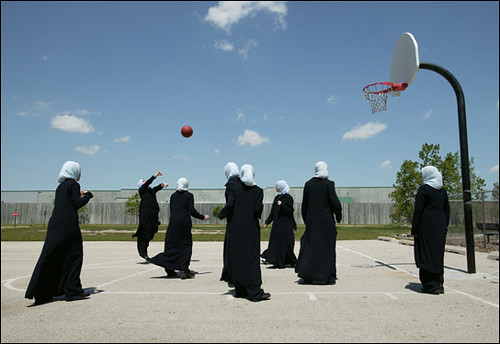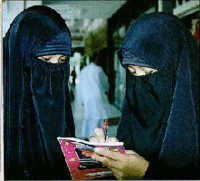 When I taught English in Qatar, my Canadian housemate Mike came up with the nickname "Shmoo" for any given Qatari woman we didn't know, a tongue-in-cheek reference to the amorphous creatures first presented in Al Capp's Lil' Abner comic strip back in 1948. It was a funny reference, if decidedly non-PC, which was drawn from the traditional (or at least claimed traditional, another argument for perhaps another post down the line) abaya (black over-covering uniformly worn by Gulf women) and shayla (headscarf covering only the hair, again black in the Gulf) worn by all Qatari women. Sometimes you just couldn't tell who was who or what was going on in there, which is of course precisely the point.
When I taught English in Qatar, my Canadian housemate Mike came up with the nickname "Shmoo" for any given Qatari woman we didn't know, a tongue-in-cheek reference to the amorphous creatures first presented in Al Capp's Lil' Abner comic strip back in 1948. It was a funny reference, if decidedly non-PC, which was drawn from the traditional (or at least claimed traditional, another argument for perhaps another post down the line) abaya (black over-covering uniformly worn by Gulf women) and shayla (headscarf covering only the hair, again black in the Gulf) worn by all Qatari women. Sometimes you just couldn't tell who was who or what was going on in there, which is of course precisely the point.The whole proper Islamic get-up for the ladies is often referred to as hijab.
 A fellow gets to know his abayas from his shaylas pretty quickly, and I'm always surprised when major media outlets just don't get these things right.
A fellow gets to know his abayas from his shaylas pretty quickly, and I'm always surprised when major media outlets just don't get these things right.Just tonight I came across an AP article titled Mermaid statue draped in Muslim dress about an apparent Danish protest over Turkey joining the EU. If you want to get some attention in Denmark, you screw ... with the ... mermaid statue. (I've been to the statue myself, and was most struck by the fact that it really is little, which was not what I expected. This drew a comment from my Danish host that they told us in the title of the darn thing that it was a Little Mermaid, and only an American would expect that to mean a large statue of a mermaid who was in fact little "in real life.")
In any event, this article stated that the mermaid was draped in a "burqa, the head-to-toe Islamic robe." Wrong, wrong and wrong...
This is the mermaid in her protest outfit:

Sorry, AP, that's no burqa! A burqa is an industrial-strength Afghan/Pakistani woman-sealant tent of clothing involving a mask-like netting and entirely too much cloth. The burqa is what the Taliban was requiring in Afghanistan, what is still preferred by many Afghani (and some Pakistani) families, and is considered entirely too much by the average Muslim woman. Look at the statue; see a face? That ain't no burqa. Sloppy, AP, sloppy!
This is the best segue I'll ever have to link to video of the bizarre funky underground European club hit by the genuine article Afghani-German music project Burka Band - "Burka Blue." It's worth it to sit through the German anchorman's spiel, trust me on this.
This is an accurately described photo of a woman in a burqa, either in Afghanistan or Pakistan but I'd be willing to guess in a Pashtun region of either:
 There are few or no Islamic women in Europe wearing burqas, although you might encounter the niqab, the more reasonable (as these things go) facial veil favored primarily in the Arabian Gulf. And those look like the picture to the right.
There are few or no Islamic women in Europe wearing burqas, although you might encounter the niqab, the more reasonable (as these things go) facial veil favored primarily in the Arabian Gulf. And those look like the picture to the right.  These days you don't see the niqab all that much in comparison even in the Gulf, unless you're in Saudi which has a corps of mutawa'een enforcing these things. This headgear is also favored by a number of African-American "reverts" to Islam who seem to have mistaken themselves for wealthy Wahhabists:
These days you don't see the niqab all that much in comparison even in the Gulf, unless you're in Saudi which has a corps of mutawa'een enforcing these things. This headgear is also favored by a number of African-American "reverts" to Islam who seem to have mistaken themselves for wealthy Wahhabists:Bloom and Blair also write that the Qur'an doesn't require women to wear veils; rather, it was a social habit picked up with the expansion of Islam. In fact, since it was impractical for working women to wear veils, "A veiled woman silently announced that her husband was rich enough to keep her idle." - Bloom, Jonathan; Blair, Sheila (2002). Islam: A Thousand Years of Faith and Power. Yale University Press.Your average Gulf woman isn't veiled these days either; I could never get a shot of my own students in Qatar but the majority of them looked like this every day, at least while wearing the abayas in front of my prying male eyes:
 Note the matching bag and heels. Some of the younger girls wore the wildest eye and lip makeup and manicures/pedicures imaginable, and would often wear very high heels that suggested going out clubbing more than English class. At home and in all-female situations the ladies are said to be quite modern and stylish, trying to out-fashion each other when the abayas, which are outer garments, pop off when the men are gone. I believe it. This photo is courtesy the Muslim woman who runs the blog Precious Modesty, which is keeping tabs on what outfits are at once halal and chic. And good luck with that...
Note the matching bag and heels. Some of the younger girls wore the wildest eye and lip makeup and manicures/pedicures imaginable, and would often wear very high heels that suggested going out clubbing more than English class. At home and in all-female situations the ladies are said to be quite modern and stylish, trying to out-fashion each other when the abayas, which are outer garments, pop off when the men are gone. I believe it. This photo is courtesy the Muslim woman who runs the blog Precious Modesty, which is keeping tabs on what outfits are at once halal and chic. And good luck with that...The original Danish protestor isn't even apparently aware of what Turkish women actually wear these days, which ranges from this to this and beyond. I think Denmark can deal with that just fine.
It looks like the mermaid was cloaked in more of an Iranian chador, although many Iranian women don't wear those either whenever possible.

The article also slipped up in the fact that there are any number of men's "Islamic robes" as well, ranging from your Gulf Arab thaub (this dapper fellow on the right looks to be wearing his at a wedding) to your South Asian salwar kameez.

No comments:
Post a Comment